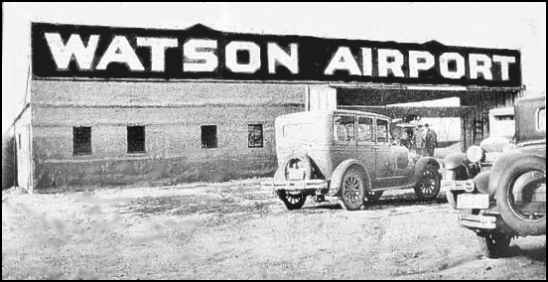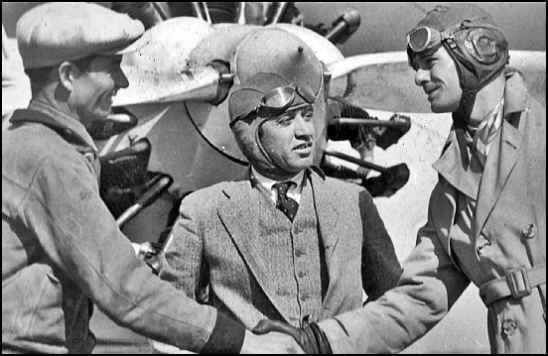
1894-1955 |
 |
With Best Wishes Hugh Watson From the Collection of Joe Gertler |
 |
Contributed by Deborah Coffman, 1-26-12 |
|
By permission from the American Yankee Association, 1-12-06 A wartime pilot instructor and aviation pioneer, Major Hugh Watson, along with his brother Parks, helped the city of Cincinnati determine the location for an airport in what was then a rural area. A plateau just north of Cooper Road was identified as the ideal site to serve the needs of the rapidly expanding metropolitan area. The Watsons established Grisard Field, named after a valiant pilot who was a casualty in The Great War. Grisard field quickly became a busy airfield and a base for airmail service, and every weekend hundreds of spectators gathered to watch planes and pilots. As early as 1921, there were airshows held at the field, already renamed Watson Airport. Development along Reed-Hartman Highway and Glendale-Milford Road thrived, due in part to the access provided by the airport. While Lunken Field (LUK) became another busy field, its valley location makes it susceptible to flood and fogs even today. This is how it earned its nickname "Sunken Lunken." It is common today to depart Blue Ash VFR, fly the nine miles to Lunken and shoot real IFR approaches. City leaders knew during the late 1930s that they had to establish a major airport to handle the growing aviation industry and considered designating Watson Airport as its prime airport. Nearby industries had been built up, and with them grew the need for quick access to this new mode of transportation. But with the World War II starting, the Army Air Corps began to build their training bases throughout the Midwest, often located away from metropolitan areas for secrecy. What is now the large Cincinnati-Northern Kentucky Airport (CVG) in Covington, Kentucky, was first used as a base for bomber training. Soon after the war ended, Cincinnati again considered making Watsons Airport the city's primary airfield. The Watson brothers sold the airfield to the city of Cincinnati, and the city renamed it Blue Ash Airport. But with the war had come the development of larger planes powered by jet engines and the need for longer runways. In 1946, the decision was made to give the Kentucky site the go-ahead for expansion as the primary metropolitan airport, with Blue Ash and Lunken serving as satellite fields for corporate and general aviation. Today Blue Ash Airport continues to serve as an important base for charter, corporate, and general aviation, far enough from the main airport to not interfere with commercial traffic. Close to both north/south interstates, as well as the major east/west roads, it offers quick and easy access. Property values around the Blue Ash area have soared as major businesses locate near this vital link to transportation. On any given day, a wide variety of aircraft operate out of the airport. Business-class turbine and jet aircraft drop off and pick up their executive passengers, most of the traffic watch operations are based here, and heavy lift helicopters use Blue Ash as their base when working in this area. Pilots from all over the country visit the field, renowned for its fine service, excellent location, and high degree of maintenance. This single strip facility handles over 50,000 takeoffs and landings a year, by FAA estimates. For over 80 years folks have stood here and watched the planes and their pilots, from the earliest pioneers of aviation in their biplanes of wood and fabric, to the modern aircraft and sleek business jets. |
from Joe Gertler "Feel free to include my email address with your references and feel free to mention that I own the complete, original archives of The Wright Company (1909-1915); the Glenn Curtiss archives (1910-1923); and the "first' Glenn Martin Co.(1912-1917) Cheers, Joe Gertler" Joe's email address is joe@memaerobilia.com |
 |
Editor's Note:This photo probably shows Hugh, in the center, and his brother M. Parks Watson to the right. If you can help with this identification, please contact me. Contributed by Deborah Coffman, 1-26-12 |
|
|
|
"Blue Ash carved out its own piece of local aviation history when two brothers, Parks and Hugh Watson, founded their own municipal airports. In the 1920s, Hugh Watson established what is now the Blue Ash Airport, on Glendale-Milford Road, which was sold to Cincinnati in 1955. Louis Glos, owner of Co-Op Aircraft Service, has been at the airport since 1952. On a wall behind his desk hangs a picture of him with Hugh Watson in 1954, just before the sale of the airport. Mr. Watson ''signed the option papers for the sale to the city of Cincinnati in October. This was the last weekend that he was here, '' Mr. Glos said of the picture. Soon after, Mr. Watson left to fly to Georgia and suffered a severe heart attack. He got well enough to deliver the deed on Jan. 10, 1955, and died Jan. 22, Mr. Glos said." You can enjoy the entire story by clicking on the title above. |
| Editor's Note: I spoke by telephone this morning, (1-12-06), with Carl Glos, the son of Louis Glos. The picture of Louis and Hugh, which celebrated the 25th anniversary of the purchase of the airport and bears some 60 autographs, still hangs on the wall. Carl hopes to arrange for me to have a copy of the photograph to put on this page. They still own and operate the Co-op Aircraft Service on the Blue Ash Airport. |
|
"The Watson Bros. Bistro & Brewery is situated alongside East Lake at the town’s main intersection "Reed Hartman and Pfeiffer Roads" just across the street from the Blue Ash Airport, the oldest airport in southwestern Ohio. The restaurant is named after the Watson brothers, two locally famous aviators who started the airport in the early 1920s, and were contemporaries of the Wright brothers." You can learn more about the restaurant by clicking on the title above. However, the restaurant was found to be closed as of January 27, 2012 |
|
|
|
If you have any more information on this Early Bird, please contact me. E-mail to Ralph Cooper Back 

|